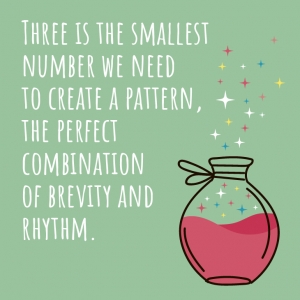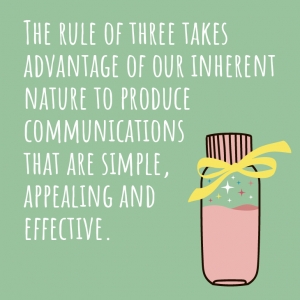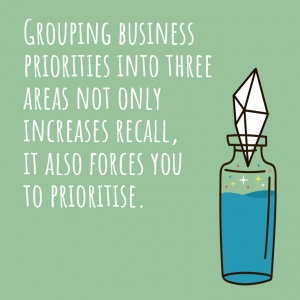
Look at those threes!
The universe did it.
Thanks for tuning in.
Why three is the magic number
15th Jan 2018
Here’s a fun game. Next time you’re out and about, pay attention to the messages that assail you through advertisements, slogans or headlines as you’re going about your day. How many of them use groups of three words or phrases?
If you’ve been in communications for any length of time you’ve no doubt come across the rule of three. But how much do you use it? And why is it so powerful?
For the uninitiated, the rule of three suggests that words grouped into threes are more appealing and easier to remember. Our brains are pattern-seeking machines, constantly looking for relationships and meaning in the world around us. Three is the smallest number we need to create a pattern, the perfect combination of brevity and rhythm.
It’s a principle captured neatly in the Latin phrase omne trium perfectum: everything that comes in threes is perfect, or, every set of three is complete.
Research gives further evidence on why three is the magic number. One recent study found that in advertisements, speeches and other messages designed to have a persuasive effect, three claims will persuade, but four or more will trigger scepticism – and may even reverse an initially positive impression.
The rule of three also governs how we talk to each other in daily conversation. According to speechwriter Max Atkinson, author of Lend Me Your Ears, studies show that listeners will wait for a speaker to find a third item in a list before taking their turn to speak. But if they go beyond three to a fourth item, the speaker will usually get interrupted. The third item marks a sense of completeness, and we have an ingrained tendency to wait for it.
We can use the rule of three to powerful effect. Its simplicity also makes it ideal advice to help leaders and managers improve their own communications. Here are three ways to put it into practice.
Create powerful messages
Browse any famous speech on YouTube and you’re likely to find liberal use of groups of three.
US President Barack Obama is a great example. Not only was his campaign slogan ‘Yes We Can’ composed of three words, but his speeches are peppered with groups of three. In his famous 2008 Presidential acceptance speech he used groups of three at least 12 times. They were part of what gave his speeches such a lyrical quality. And they can be just as effective in writing.
Try these techniques from Max Atkinson for incorporating groups of three into your work:
- Use three identical words – as in Tony Blair’s famous use of ‘Education, education and education’ to set out his top three priorities for Government.
- Use three different words – such as ‘Friends, Romans, Countrymen’ from William Shakespeare’s Julius Caesar.
- Use three phrases – as in Abraham Lincoln’s ‘Government of the people by the people for the people’.
- Use three sentences – as demonstrated by Winston Churchill’s historic description of the Battle of Britain: ‘This is not the end. It is not even the beginning of the end. But it is, perhaps, the end of the beginning.’
- Put the longest item last – as in ‘the inalienable right to life, liberty and the pursuit of happiness’, from the American Declaration of Independence.
Make your campaigns memorable
Communication campaigns are worthless unless people remember them: they just create more noise.
Research shows that our brains can comfortably process up to three ‘chunks’ of information in our short-term memory. Above that, they need to work much harder. This insight can help us devise campaign names and materials that have a far higher chance of being remembered.
For example, ‘A Mars a day helps you work, rest and play’ fuelled over 30 years of market-topping sales of the ubiquitous chocolate bar.
‘Stop, Look and Listen’ helped millions of children cross the road safely, while ‘Slip-Slop-Slap’ persuaded a generation of Australians to guard against skin cancer. Both these safety campaigns succeeded because they were easy to remember, and easy to follow.
Another challenge for communicators is helping employees understand their organisation’s purpose, objectives or strategy.
Unfortunately, business strategy and plans are rarely produced in communication-ready format. It’s often up to us to translate them for the wider business, and the rule of three can help here too. Grouping business priorities into three areas for communication purposes not only increases recall, it also forces you – and your organisation – to prioritise.
After all, as management guru Jim Collins wrote: ‘If you have more than three priorities, you don’t have any’.
Focus your presentations
Many business presentations are ineffective because they’re rambling and unfocused. That’s why communication and pitch experts suggest using a three-part structure for presentations. It’s one of the easiest and most effective ways of structuring your message.
In Talk Like Ted, communications expert Carmine Gallo recommends creating a message map on a single piece of paper to plan any pitch or presentation. It consists of three steps:
- First, create a simple headline for your presentation: the single most important thing you want your audience to know about your product, service or idea.
- Next, write three key messages that support your overall theme. If you have more, use three categories instead.
- Finally, create three supporting points for each of your messages, using a combination of stories, statistics, examples or anecdotes.
Using this framework can help you communicate more effectively in almost any scenario – from elevator pitches to meetings to full presentations. It’s also simple and effective advice to give leaders and managers when supporting them in developing their own communication material.
The rule of three takes advantage of our inherent nature to produce communications that are simple, appealing and effective. Whatever our communication aims, it can sprinkle a little stardust on our efforts and increase our chances of success.
Three really is the magic number.
By Dave Wraith for Alive!
+++++++++++++++++++++++++++++++++++++++++++++++++++++++++++++++++++++++
+++++++++++++++++++++++++++++++++++++++++++++++++++++++++++++++++++++++
+++++++++++++++++++++++++++++++++++++++++++++++++++++++++++++++++++++++
- Bloggery committed by chris tower - 2404.03 - 10:10
- Days ago = 3197 days ago
- New note - On 1807.06, I ceased daily transmission of my Hey Mom feature after three years of daily conversations. I plan to continue Hey Mom posts at least twice per week but will continue to post the days since ("Days Ago") count on my blog each day. The blog entry numbering in the title has changed to reflect total Sense of Doubt posts since I began the blog on 0705.04, which include Hey Mom posts, Daily Bowie posts, and Sense of Doubt posts. Hey Mom posts will still be numbered sequentially. New Hey Mom posts will use the same format as all the other Hey Mom posts; all other posts will feature this format seen here.


No comments:
Post a Comment